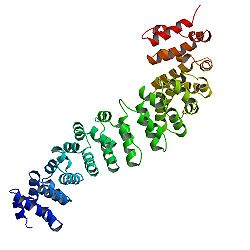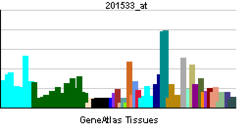Catenin beta-1, also known as β-catenin (beta-catenin), is a protein that in humans is encoded by the CTNNB1 gene.
β-Catenin is a dual function protein, involved in regulation and coordination of cell–cell adhesion and gene transcription. In humans, the CTNNB1 protein is encoded by the CTNNB1 gene.[5][6] In Drosophila, the homologous protein is called armadillo. β-catenin is a subunit of the cadherin protein complex and acts as an intracellular signal transducer in the Wnt signaling pathway.[7][8][9] It is a member of the catenin protein family and homologous to γ-catenin, also known as plakoglobin. β-Catenin is widely expressed in many tissues. In cardiac muscle, β-catenin localizes to adherens junctions in intercalated disc structures, which are critical for electrical and mechanical coupling between adjacent cardiomyocytes.
Mutations and overexpression of β-catenin are associated with many cancers, including hepatocellular carcinoma, colorectal carcinoma, lung cancer, malignant breast tumors, ovarian and endometrial cancer.[10] Alterations in the localization and expression levels of β-catenin have been associated with various forms of heart disease, including dilated cardiomyopathy. β-Catenin is regulated and destroyed by the beta-catenin destruction complex, and in particular by the adenomatous polyposis coli (APC) protein, encoded by the tumour-suppressing APC gene. Therefore, genetic mutation of the APC gene is also strongly linked to cancers, and in particular colorectal cancer resulting from familial adenomatous polyposis (FAP).
- ^ a b c GRCh38: Ensembl release 89: ENSG00000168036 – Ensembl, May 2017
- ^ a b c GRCm38: Ensembl release 89: ENSMUSG00000006932 – Ensembl, May 2017
- ^ "Human PubMed Reference:". National Center for Biotechnology Information, U.S. National Library of Medicine.
- ^ "Mouse PubMed Reference:". National Center for Biotechnology Information, U.S. National Library of Medicine.
- ^ Kraus C, Liehr T, Hülsken J, Behrens J, Birchmeier W, Grzeschik KH, Ballhausen WG (September 1994). "Localization of the human beta-catenin gene (CTNNB1) to 3p21: a region implicated in tumor development". Genomics. 23 (1): 272–274. doi:10.1006/geno.1994.1493. PMID 7829088.
- ^ MacDonald BT, Tamai K, He X (July 2009). "Wnt/beta-catenin signaling: components, mechanisms, and diseases". Developmental Cell. 17 (1): 9–26. doi:10.1016/j.devcel.2009.06.016. PMC 2861485. PMID 19619488.
- ^ Peifer M, Rauskolb C, Williams M, Riggleman B, Wieschaus E (April 1991). "The segment polarity gene armadillo interacts with the wingless signaling pathway in both embryonic and adult pattern formation". Development. 111 (4): 1029–1043. doi:10.1242/dev.111.4.1029. PMID 1879348.
- ^ Noordermeer J, Klingensmith J, Perrimon N, Nusse R (January 1994). "dishevelled and armadillo act in the wingless signalling pathway in Drosophila". Nature. 367 (6458): 80–83. Bibcode:1994Natur.367...80N. doi:10.1038/367080a0. PMID 7906389. S2CID 4275610.
- ^ Peifer M, Berg S, Reynolds AB (March 1994). "A repeating amino acid motif shared by proteins with diverse cellular roles". Cell. 76 (5): 789–791. doi:10.1016/0092-8674(94)90353-0. PMID 7907279. S2CID 26528190.
- ^ Morin PJ (December 1999). "beta-catenin signaling and cancer". BioEssays. 21 (12): 1021–1030. doi:10.1002/(SICI)1521-1878(199912)22:1<1021::AID-BIES6>3.0.CO;2-P. PMID 10580987. S2CID 86240312.





